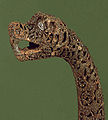- Norse art
-
Norse art is a blanket term for the artistic styles in Scandinavia during the Germanic Iron Age, the Viking Age (known as Viking art), and sometimes even used when describing objects from the Nordic Bronze Age. Viking art has many elements in common with Celtic Art, Romanesque art and East-European (Eurasian) Art[1]. There are six main styles; Oseberg, Borre, Jellinge, Mammen, Ringerike and Urnes style. The Jelling style is named after the Jelling royal grave where the Jelling stones are located, and features prominent animal designs. The Ringerike style is characterized by elaborate foliage ornament and interlacing and is named after the district in Norway where it is represented in local sandstone. Detailed designs in carved doors of Urnes stave church in the Sognefjord, Norway gave its name to the final style.
Contents
Examples
- Ladbyskibet, the only Danish ship burial. The ship and its owner are buried in Ladbyhøj together with 11 horses and at least 4 dogs. It is located close to Kerteminde on Funen, Denmark. The ship was decorated with a dragon's head in the bow. Today only the dragon's coily mane made of iron remains.
- Copies of the two golden horns of Gallehus from around the 4th century. The copies can be seen at Nationalmuseet in Denmark. The original horns were stolen and destroyed in 1802.
- Gundestrupkarret (the Gundestrup Cauldron) is a Celtic-style[citation needed] cauldron from the Iron Age. It was found in Denmark. It is housed at the National Museum of Denmark.
- The Solvogn (the Trundholm sun chariot) is from the Bronze Age. It was found in a bog in 1902 in Denmark. In the Danish Bronze Age mythology it was believed that the sun was carried over the sky on a carriage from noon to evening. At night the sun was escorted by a snake to the night ship that transported it until morning. A fish then escorted the sun to the morning ship that transported it until the horse took over again. Solvognen is housed at the National Museum of Denmark.
- A copy of The Cammin Casket, housed at the National Museum of Denmark. The original casket was lost during World War II. The casket was made in the late Viking Age (around year 1000 AD) in the southern Scandinavia. It is made out of wood, elk horn and bronze and is an example of Norse art with rich carvings in Mammen style. The shape of the casket represents the shape of a Viking house.
- Oseberg longship - an example of Norse art and craftsmanship.
Gallery
See also
Notes
- ^ Maurizio Tani, Le origini mediterranee ed eurasiatiche dell’arte vichinga. Casi esemplari dall’Islanda, in Studi Nordici (Roma), XIII, 2006, pp. 81-95
References
- Maurizio Tani, Le origini mediterranee ed eurasiatiche dell’arte vichinga. Casi esemplari dall’Islanda, in Studi Nordici (Roma), XIII, 2006, pp. 81–95
- http://www.tiscali.co.uk/reference/encyclopaedia/hutchinson/m0023723.html
- Michael Neiß: Fenrisulv och Midgårdsorm. Två grundmotiv i vendeltidens djurornanmentik. (Kontinuitetsfrågor i germansk djurornamentik I.).Mit deutscher Zusammenfassung. In: Fornvännen 99. Stockholm 2004.http://fornvannen.se/pdf/2000talet/2004_009.pdf
- Michael Neiß: The ornamental Echoe of Oðinn’s Cult.(Kontinuitetsfrågor i germansk djurornamentik II) In: ”Ulf Fransson (red.). Cultural Contacts between East and West. Stockholm 2007 http://michaelneiss.hardell.net/Festschrift/index.pdf
Categories:
Wikimedia Foundation. 2010.











